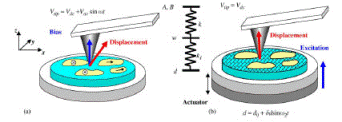Department of Physics and Astronomy: Publications and Other Research

Alexei Gruverman Publications
Document Type
Article
Date of this Version
3-23-2005
Abstract
Nanoscale polarization switching in ferroelectric materials by piezoresponse force microscopy in weak and strong indentation limits is analyzed using exact solutions for coupled electroelastic fields under the tip. Tip-induced domain switching is mapped on the Landau theory of phase transitions, with domain size as an order parameter. For a point charge interacting with a ferroelectric surface, switching by both first and the second order processes is possible, depending on the charge–surface separation. For a realistic tip, the domain nucleation process is first order in charge magnitude and polarization switching occurs only above a certain critical tip bias. In pure ferroelectric or ferroelastic switching, the late stages of the switching process can be described using a point charge model and arbitrarily large domains can be created. However, description of domain nucleation and the early stages of growth process when the domain size is comparable with the tip curvature radius (weak indentation) or the contact radius (strong indentation) requires the exact field structure. For higher order ferroic switching (e.g., ferroelectroelastic), the domain size is limited by the tip–sample contact area, thus allowing precise control of domain size.


Comments
Published in J. Appl. Phys. 97, 074305 (2005). Copyright © 2005 American Institute of Physics. Used by permission.